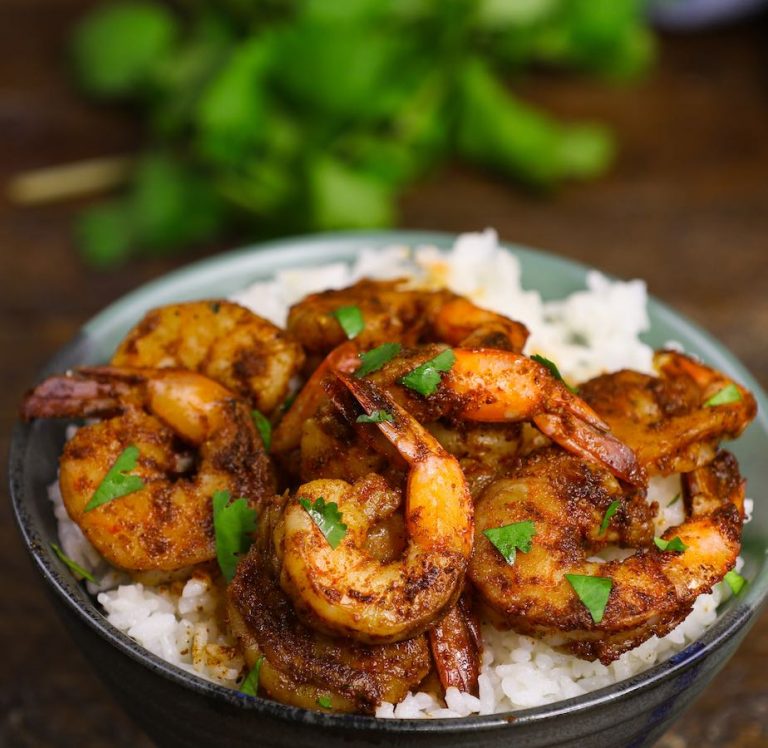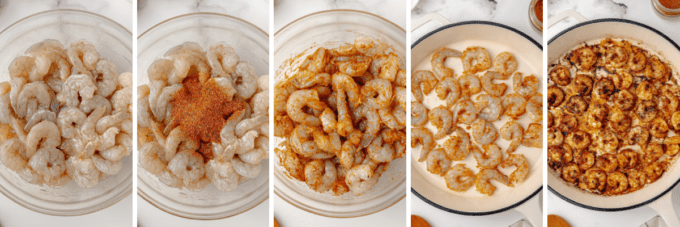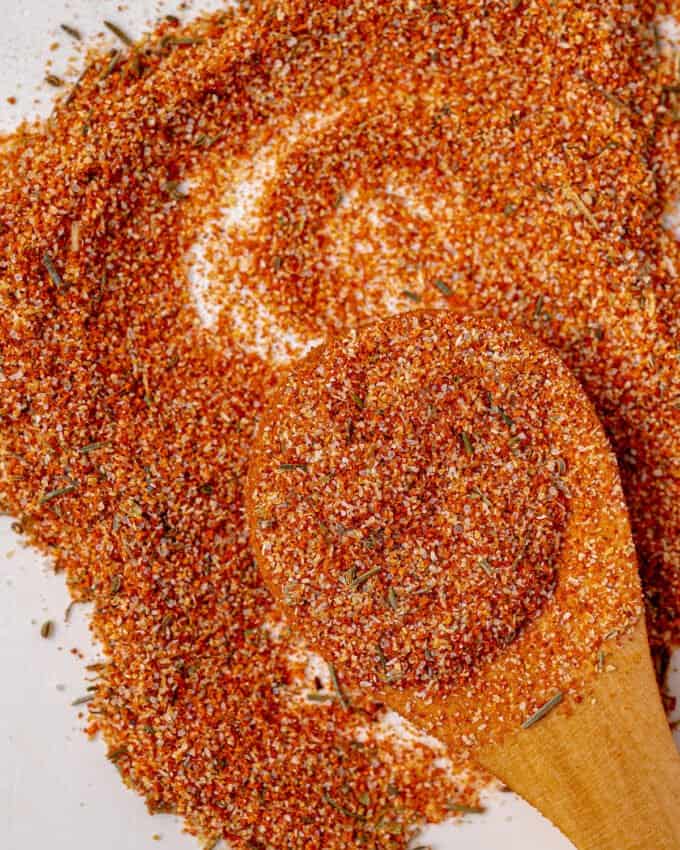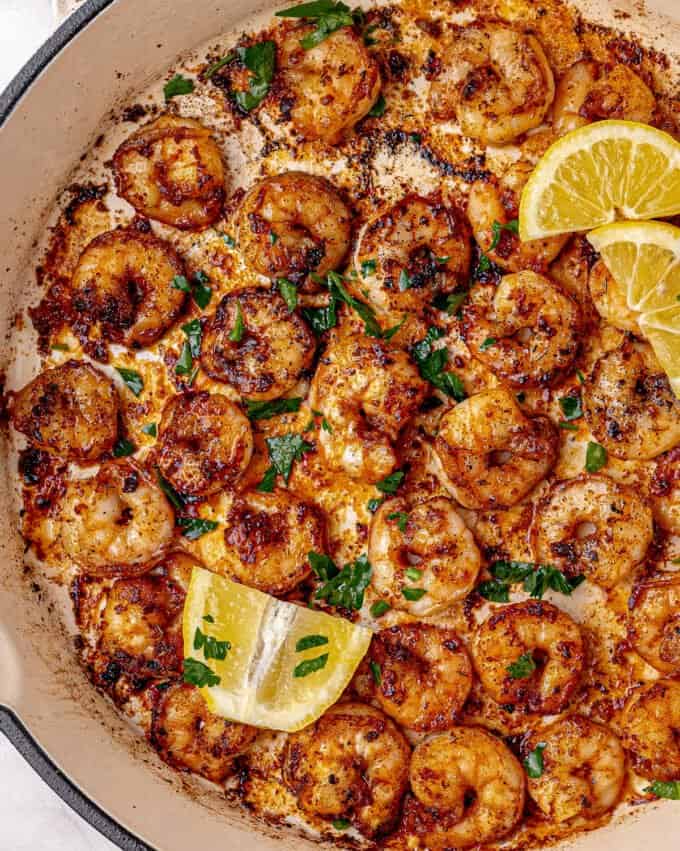A homemade blackening seasoning is mixed with butter and used to coat juicy, tender shrimp. The shrimp are then seared until they are perfectly cooked with a little char. This easy shrimp recipe is made in less than 20 minutes!.
Some of my favorite things to cook are shrimp recipes because they’re so easy and quick to make.
Plus, you’ll only have one pan and one bowl to wash after dinner. If I’ve just cooked dinner, the last thing I want to do is wash a bunch of dishes. What about you? One pan dinners for the win!.
This blackened shrimp recipe gives you both the blackened shrimp recipe and my recipe for homemade blackening seasoning.
The seasoning is so flavorful and savory, and perfect on just about every kind of protein or vegetable!
If you think it might be too spicy, you can change how much cayenne pepper you use.
To make twice as much seasoning, put it in a container that won’t let air in. Keep it at room temperature for months. Plus, you’ll know exactly what’s in it!.
Blackened shrimp is a popular Cajun-inspired dish that looks fancy but is surprisingly easy to make at home. With just a few basic ingredients and techniques you can make restaurant-quality blackened shrimp that will wow your family and friends.
What is Blackened Shrimp?
Blackened shrimp refers to shrimp that is seasoned with a spicy herb-heavy “blackening” spice blend then seared in a cast iron skillet until blackened on the outside but still moist inside. The term “blackened” doesn’t mean the shrimp is burnt – it just refers to the charred blackened crust that forms from searing it over high heat.
Blackening is a cooking technique commonly used in Cajun and Creole cuisines. It involves coating food in a well-balanced, robust blend of spices that forms a flavorful, addictive crust when exposed to high heat. This cooking method seals in moisture while adding tons of big, bold flavor.
How to Make Blackened Shrimp
Making blackened shrimp at home is easy. Here’s a step-by-step guide
Ingredients Needed
- Shrimp – peeled, deveined large shrimp work best
- Blackening seasoning – either homemade or store-bought
- Butter – for coating the shrimp
- Vegetable oil – for the skillet
- Lemon wedges – for serving
- Fresh parsley or cilantro (optional) – for garnish
Prepare the Shrimp
Start by peeling and deveining the shrimp if needed. Pat the shrimp very dry with paper towels – this helps the seasoning stick.
Make the Blackening Seasoning
While you can use store-bought, homemade blackening seasoning is worth the small effort.
To make it, just mix together paprika, onion powder, garlic powder, dried oregano, dried thyme, cayenne pepper, salt, and pepper in a small bowl. Adjust the amounts of each to suit your tastes.
Store extra seasoning in an airtight container for up to 6 months.
Coat the Shrimp
Melt the butter in a small bowl and toss the shrimp in it. This adds flavor and helps the seasoning stick.
Then sprinkle the blackening seasoning generously over the buttered shrimp, tossing to coat evenly. Really press the seasoning into the shrimp.
Sear the Shrimp
Heat 1 Tbsp vegetable oil in a cast iron skillet over medium-high heat until smoking. Working in batches, add the shrimp in an even layer and cook for 1-2 minutes per side. The shrimp will sizzle and blacken as they cook.
Once seared, remove the shrimp and repeat with remaining shrimp.
Finish and Serve
Give the shrimp a final toss in the skillet to rewarm if needed. Serve immediately with lemon wedges for squeezing over top and a sprinkle of chopped fresh parsley or cilantro.
Enjoy the shrimp as is, or incorporate into tacos, salads, pasta, or po’ boys. The possibilities are endless!
Tips for Perfect Blackened Shrimp
Follow these tips for the best blackened shrimp every time:
- Pat shrimp very dry before seasoning.
- Use a heavy cast iron skillet for the best sear. Lodge makes a great reasonably priced cast iron skillet.
- Make sure the skillet is screaming hot before adding shrimp.
- Work in batches to avoid overcrowding the pan and steaming instead of searing.
- Flip shrimp just once during cooking for optimal sear.
- Pull shrimp from the skillet as soon as they are opaque and blackened. Overcooking makes them rubbery.
- Let skillet reheat between batches for best results.
- Add a pinch more seafood seasoning than you think you need – the bold flavors pair perfectly.
- Serve immediately for max juiciness and flavor.
The Best Shrimp to Use
While any shrimp will work, larger shrimp like jumbo or colossal are best for blackening since they stand up to bold seasonings and high heat cooking. Medium to large shrimp (26/30 or 21/25 count per pound) are ideal.
When purchasing shrimp, look for fresh, firm, shiny shells free of black spots. Avoid shrimp with an ammonia odor. Shells should look moist but not slimy.
You can use freshly cooked or raw shrimp. Thaw frozen shrimp overnight in the fridge before using.
Make-Ahead Blackened Shrimp
For best flavor and texture, blackened shrimp is best cooked right before serving. However, you can prep the shrimp up to the point of cooking:
- Make blackening seasoning ahead and store in an airtight container for months.
- Peel, devein, and dry shrimp up to 1 day ahead. Store covered in the fridge.
- Toss prepared shrimp with melted butter and blackening seasoning up to 4 hours before cooking. Cover and refrigerate.
Just don’t actually cook the shrimp until ready to serve. Reheating pre-cooked shrimp can cause them to turn rubbery.
Serving Suggestions
Blackened shrimp makes a tasty appetizer or main course. Here are some serving ideas:
- Stuff into tacos, po’ boys or sandwiches
- Serve over grits or cheesy pasta
- Mix into salad
- Enjoy as-is with lemon and extra seasoning
- Pair with rice and remoulade sauce for dipping
No matter how you serve them, blackened shrimp always disappears fast! Adjust the heat to your liking by modifying the amount of cayenne in the seasoning.
FAQs About Making Blackened Shrimp
Here are answers to some common questions about making blackened shrimp at home:
Is blackened shrimp spicy?
It can be! Blackening seasoning often contains cayenne pepper or other dried chiles which provide heat. But you can control the spice level by adjusting the amount of cayenne or omitting it altogether.
What is blackened seasoning made of?
While recipes vary, blackening seasoning typically contains some combination of paprika, garlic powder, onion powder, oregano, thyme, cayenne pepper, black pepper, salt, and sometimes celery seed or other spices.
Can you use Old Bay to make blackened shrimp?
You can, but it won’t provide the authentic Cajun blackening seasoning flavor. Old Bay contains similar spices but less heat. For best flavor, use a spice blend made specifically for blackening.
What is the black stuff on blackened food?
The black exterior on blackened shrimp and other food isn’t burnt or overcooked. It’s a result of the spices in the seasoning turning dark when exposed to high heat during cooking. The flavorful black crust is the signature of blackened cuisine.
How do you keep blackened shrimp from sticking?
Cooking in a well-seasoned cast iron skillet prevents sticking. Make sure shrimp are dry before seasoning, and allow the skillet to preheat before adding shrimp. Use enough oil to coat the pan, and don’t overcrowd. Let shrimp sear undisturbed before flipping.
Enjoy Restaurant-Worthy Blackened Shrimp at Home
With just a few pantry staples and basic techniques, you can make perfectly seasoned, seared blackened shrimp worthy of any fine dining restaurant. Impress your family with your cooking skills by serving up this Creole and Cajun classic. Once you master this easy recipe, you’ll make blackened shrimp again and again.

How to make blackened shrimp?
These are just the main points. The full list of ingredients and instructions can be found in the recipe card near the end of this post.

- Prepare shrimp. Make sure the shrimp is patted very dry.
- Toss with butter. Along with flavor, this adds water so the seasoning sticks.
- Season. Toss well so that all shrimp is coated.
- Cook. I cook this shrimp in groups so they don’t get too crowded in the pan.
You’ll want to use raw shrimp for this recipe, so they don’t get overcooked and rubbery. Personally, I choose shrimp that has already been peeled and deveined to save time. However, you can choose any kind you like. That being said, I defrosted shrimp that were frozen, but if you live near the coast and can get fresh seafood, do it!

Variations of this recipe
- Seasoning: We like to make our own blackening seasoning, but you can use store-bought if you’re in a hurry or really like a certain brand.
- Oil: The melted butter gives it a lovely richness, but you can use the same amount of oil instead. Our favorites are vegetable and avocado oil.
- If the weather is nice, you can grill these blackened shrimp. To keep the shrimp from getting lost, I would put them on skewers before putting them on the grill.
- Decorations—decorations aren’t required, but I really think you should use them in this recipe. The cilantro or parsley gives the shrimp a fresh taste, and the lemon juice really brings out the flavors of the seasoning for blackening.

This recipe can be made with any size shrimp. But as written, it uses large shrimp (between a 26-35/lb size). If you use a different size, you’ll need to change the baking time. Bigger shrimp will need more time, while smaller shrimp will need less.
While it may look like it sometimes, it’s not. The special blend of seasonings can take on a dark brown almost black color when cooked.
